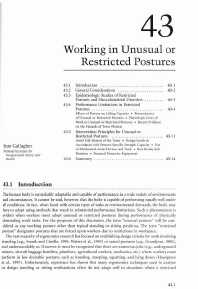Mining Publication: Working in Unusual or Restricted Postures
Original creation date: February 2006
The human body is remarkably adaptable and capable of performing in a wide variety of environments and circumstances. It cannot be said, however, that the body is capable of performing equally well under all conditions. In fact, when faced with certain types of tasks or environmental demands, the body may have to adapt using methods that result in substantial performance limitations. Such a phenomenon is evident when workers must adopt unusual or restricted postures while performing physically demanding work tasks. For purposes of this discussion, the term "unusual posture" is considered as any working posture other than typical standing or sitting positions. The term "restricted posture" denotes postures that are forced upon workers due to restrictions in work space. The vast majority of ergonomics research has focused on establishing design criteria for work involving standing or seated postures, and understandably so. However, it must be recognized that there are numerous jobs (e.g., underground miners, aircraft baggage handlers, plumbers, agricultural workers, mechanics, etc.) where workers must perform in less desirable postures, such as kneeling, stooping, squatting, and lying down. Unfortunately, experience has shown that many ergonomic techniques used to analyze or design standing or sitting work stations often do not adapt well to situations where a restricted posture is adopted. However, recent years have seen an increase in research examining the musculoskeletal risks and physical limitations associated with working in these postures. This chapter summarizes current knowledge in this area and establishes principles for ergonomic design of jobs when working in unusual or restricted postures.
Authors: S Gallagher
Book Chapter - February 2006
NIOSHTIC2 Number: 20030485
Interventions, Controls, and Applications in Occupational Ergonomics (the Occupational Ergonomics Handbook), 2006 Feb; Marras WS, Karwowski W, eds., Boca Raton, FL: CRC Press, 43.1-43.16
See Also
- Characteristics of Gait in Restricted Vertical Space Versus Unrestricted Walking
- A Checklist for Evaluating Cab Design of Construction Equipment
- The Effects of Restricted Workspace on Lumbar Spine Loading
- An Ergonomic Evaluation of Excavating Operations: A Pilot Study
- Forces and Moments on the Knee During Kneeling and Squatting
- Implementation of an Ergonomics Process at a US Surface Coal Mine
- Lifting in Stooped and Kneeling Postures: Effects on Lifting Capacity, Metabolic Cost, and Electromyography of Eight Trunk Muscles
- Locomotion in Restricted space: Kinematic and Electromyographic Analysis of Stoopwalking and Crawling
- Task-Specific Postures in Low-Seam Underground Coal Mining
- Thigh-Calf and Heel-Gluteus Contact Forces in High Flexion: Experimental Results
- Page last reviewed: 9/21/2012
- Page last updated: 9/21/2012
- Content source: National Institute for Occupational Safety and Health, Mining Program


 ShareCompartir
ShareCompartir
